Lower back pain is a universal phenomenon and one of the most common reasons for disability and medical consultations among adults. The pain can range from a mild ache to a severe and debilitating condition, disrupting daily life, work, and even sleep. Global statistics indicate that approximately 80% of people will experience lower back pain at least once in their lives. In the past, many would resort to complete rest at the first sign of pain. However, modern medical knowledge, contrary to this belief, emphasizes the importance of staying active and performing the correct exercises as the most effective strategy for managing, alleviating, and preventing back pain. This article serves as a comprehensive and authoritative guide, introducing you to the principles of physiotherapy and exercise for a healthier lower back.
1. Understanding Lower Back Pain: Why Do We Hurt?
Lower back pain can have various causes, but it is often linked to non-serious issues like strained muscles or ligaments, or problems with the spine's discs and joints. Sometimes, the pain can stem from weakness in the body's core muscles. These muscles (including the abdomen, pelvis, lower back, and diaphragm) act as a natural protective belt, shielding the spine from daily stresses. When these muscles are weak, more strain and pressure are placed on the spine and discs, which can lead to pain and injury over time.
Common Misconceptions about Back Pain:
-
Misconception: "Pain means serious damage, and I must rest completely."
-
Reality: In many cases, pain signifies nerve sensitivity or inflammation, not necessarily tissue damage. Prolonged, complete rest can worsen the condition by causing muscle weakness and joint stiffness. Gentle, controlled activities, such as short walks, can help reduce pain and accelerate recovery.
2. Physiotherapy: Beyond Massage and Machines
Physiotherapy is a specialized and holistic approach to treating musculoskeletal problems, focusing on the recovery, maintenance, and maximization of an individual's physical movement and function. A physiotherapist doesn't just work with physical tools; as a movement specialist, they identify the root cause of your problem and offer a long-term solution.
The Role of a Physiotherapist: Assessment and Treatment Plan
A physiotherapy session begins with a comprehensive assessment. The physiotherapist reviews your medical history, asks about the type and intensity of your pain, and conducts a full physical examination. This assessment includes checking your range of motion, muscle strength, posture, and movement patterns.
Based on this evaluation, the physiotherapist designs a fully personalized treatment plan, which may include:
-
Manual Therapies:
-
Mobilization: Gentle, rhythmic, and stretching movements on joints and the spine to reduce stiffness and improve range of motion.
-
Manipulation: Controlled and swift movements that may be accompanied by a "pop" sound and help release joints. This technique should only be performed by qualified professionals.
-
Soft Tissue Massage: To reduce muscle tension, improve blood flow, and alleviate pain.
-
Advanced Modalities: In addition to hands-on techniques, your plan may include modern therapies like Dry Needling or traditional methods like Dry Cupping to accelerate recovery.
-
-
Targeted Exercise Program: Providing specific exercises to strengthen weak muscles, stretch tight muscles, and improve overall body function.
-
Education and Counseling: Teaching proper posture, correct lifting techniques, and strategies to prevent future injury.
-
Other Modalities: While treatments like Transcutaneous Electrical Nerve Stimulation (TENS) were used in the past, modern medical guidelines often do not recommend them as a primary treatment due to limited evidence of long-term effectiveness. Your physiotherapist will focus on proven methods.
How to Find a Reputable Physiotherapist
As trusted sources like the Mayo Clinic and the NHS emphasize, choosing a qualified physiotherapist is crucial. Ensure your chosen professional is licensed by credible organizations. You can ask your doctor for a referral or search reputable online directories, looking for a specialist with experience in treating lower back pain.
What to Expect in Your First Session
Your first physiotherapy appointment typically involves three main parts:
-
Discussion & Interview: You will discuss your symptoms, pain history, and personal goals.
-
Physical Examination: The physiotherapist will assess how you move, your muscle strength, and your joint range of motion.
-
Plan Design: Based on the findings, the physiotherapist will establish treatment goals and outline an initial plan with you.
3. Effective Exercises for Lower Back Pain: A Step-by-Step Guide
This section is the core of your treatment program. The goal of these exercises is not only to reduce pain but also to strengthen your body to prevent a recurrence. Perform each exercise slowly and with full control. Never continue if you feel sharp or severe pain.
A) Core-Strengthening Exercises
Strong core muscles stabilize your spine.
1. Pelvic Tilt
-
Starting Position: Lie on your back with your knees bent and feet flat on the floor.
-
How to Perform: Tighten your abdominal muscles and press your lower back into the floor. Your pelvis will tilt slightly. Hold for a few seconds and gently return to the starting position.
-
Repetitions: 8 to 12 times.
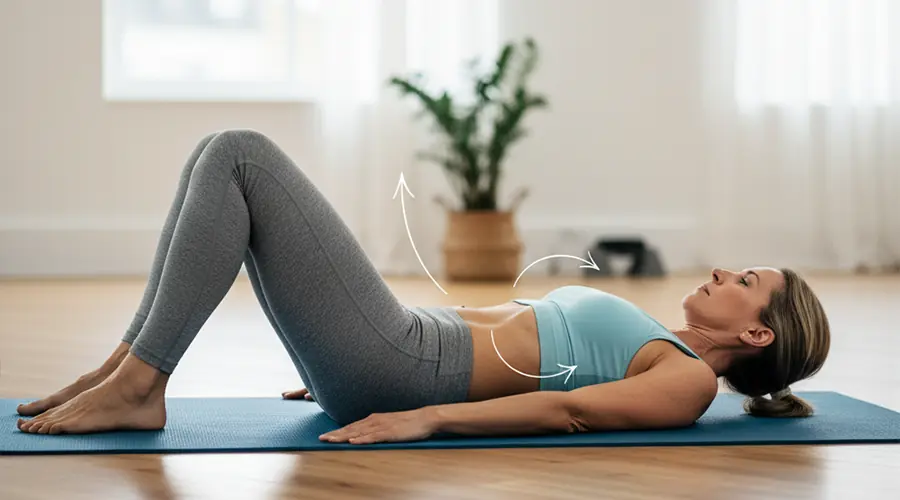
2. Bridge
-
Starting Position: Lie on your back with your knees bent and feet flat on the floor. Keep your arms by your sides.
-
How to Perform: Squeeze your gluteal (buttocks) and abdominal muscles, and gently lift your hips off the floor until your body forms a straight line from your shoulders to your knees. Avoid arching your back too much. Hold for 5 to 10 seconds.
-
Repetitions: 8 to 12 times
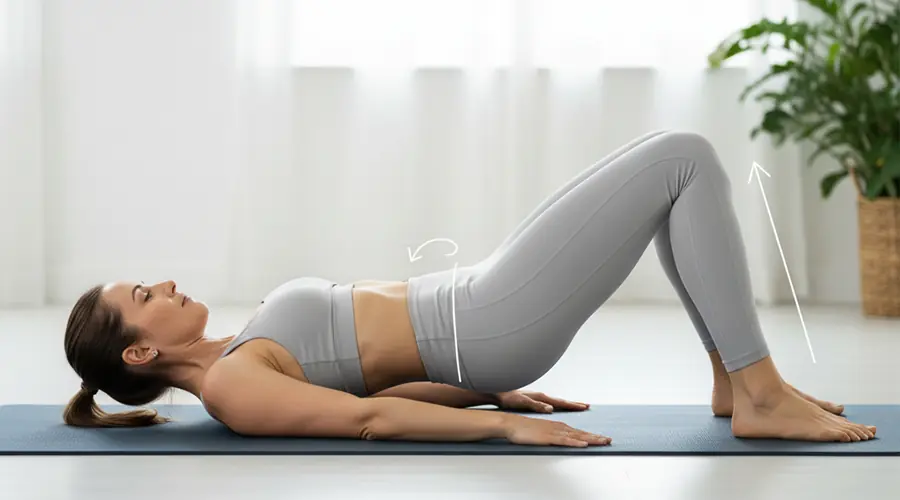
3. Bird Dog
-
Starting Position: Get on all fours, with your wrists under your shoulders and your knees under your hips.
-
How to Perform: Slowly extend one arm and the opposite leg simultaneously until your body forms a straight line. Keep your abdominal muscles tight to maintain balance. Hold for 5 to 10 seconds, then gently return to the starting position. Repeat on the other side.
-
Repetitions: 10 times for each side.
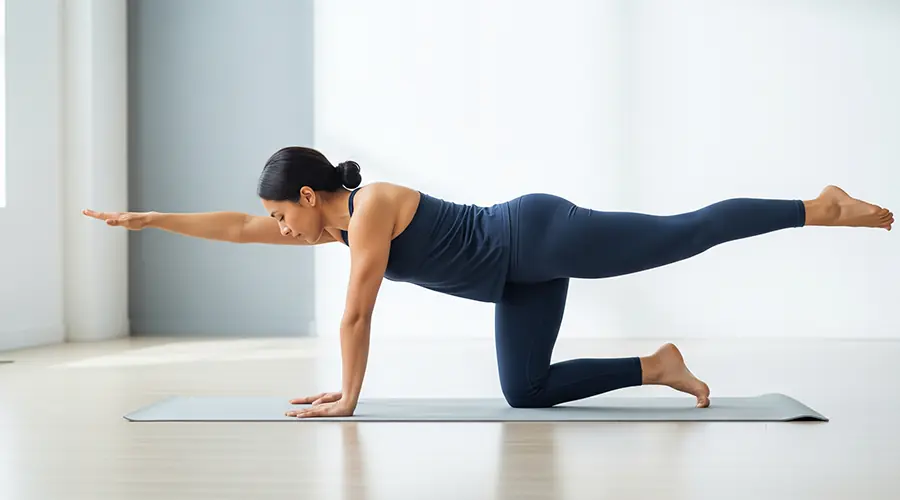
4. Plank
-
Starting Position: Lie on your stomach and then lift yourself up onto your forearms and toes. Your body should form a straight line from head to heels.
-
How to Perform: Keep your core and glutes tight, and prevent your hips from sagging. Hold this position for as long as you can (e.g., 30 seconds).
-
Repetitions: 2 to 3 sets.
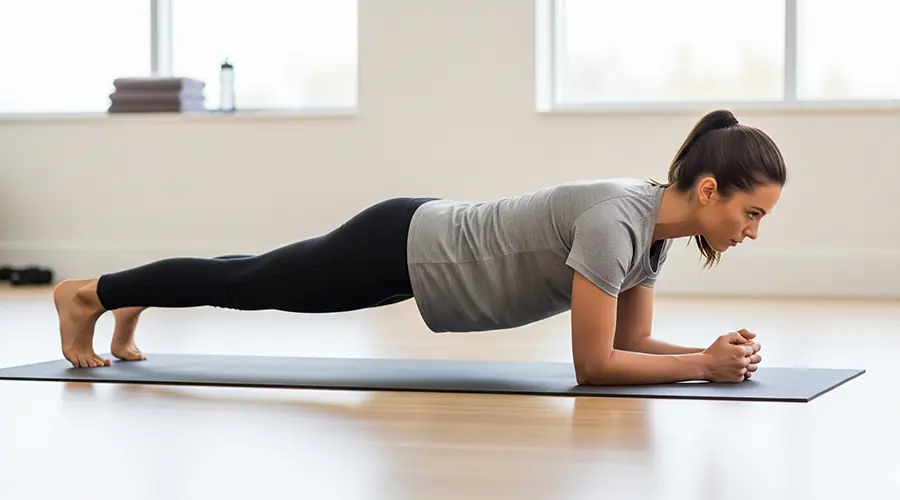
B) Flexibility and Stretching Exercises
These movements help reduce muscle stiffness and improve the range of motion in your spine and hips.
5. Knee-to-Chest Stretch
-
Starting Position: Lie on your back.
-
How to Perform: Gently pull one knee towards your chest with both hands. Hold this stretch for 15 to 30 seconds. Repeat with the other leg.
-
Repetitions: 2 to 3 times for each leg.
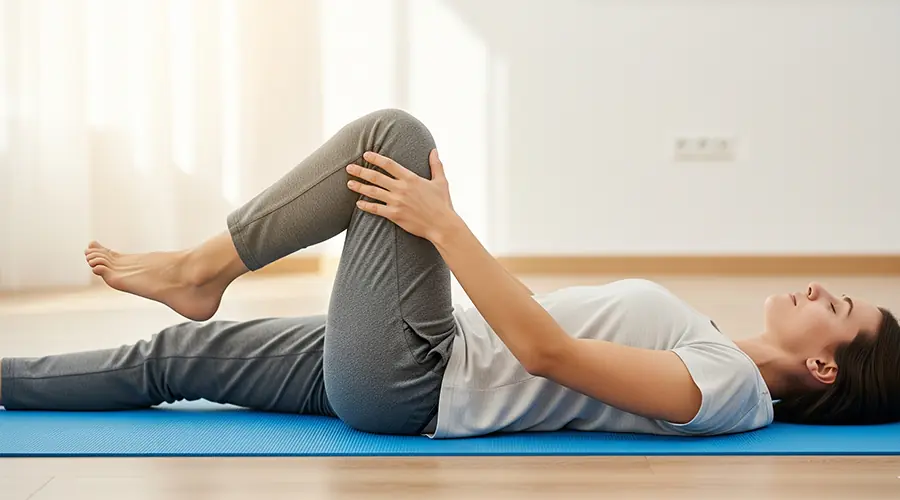
6. Lower Back Rotational Stretch
-
Starting Position: Lie on your back with your knees bent and feet flat on the floor.
-
How to Perform: Slowly let both knees fall to one side, keeping your shoulders flat on the floor. Hold the stretch for 20 seconds, then repeat on the other side.
-
Repetitions: 2 to 3 times for each side.
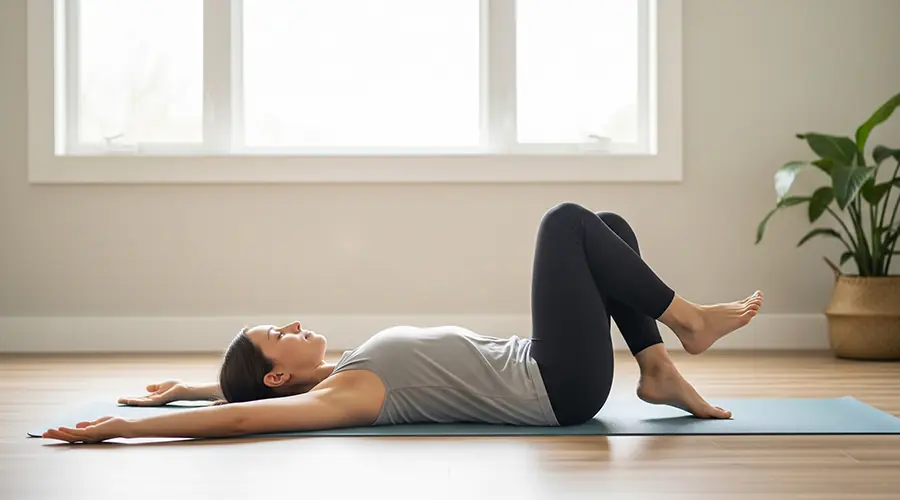
7. Child's Pose (Bottom to Heels Stretch)
-
Starting Position: Kneel on the floor with your hands stretched out in front of you.
-
How to Perform: Lower your hips back towards your heels, walking your hands forward as far as you can to feel a gentle stretch in your lower back and arms. Hold for 20 to 30 seconds.
-
Repetitions: 3 to 5 times.

8. Cat-Cow Pose
-
Starting Position: Get on all fours.
-
How to Perform: For the Cow pose, gently arch your back towards the floor, lifting your head and hips. For the Cat pose, round your back towards the ceiling and tuck your head in. Repeat these two movements fluidly with deep breaths.
-
Repetitions: 10 times.
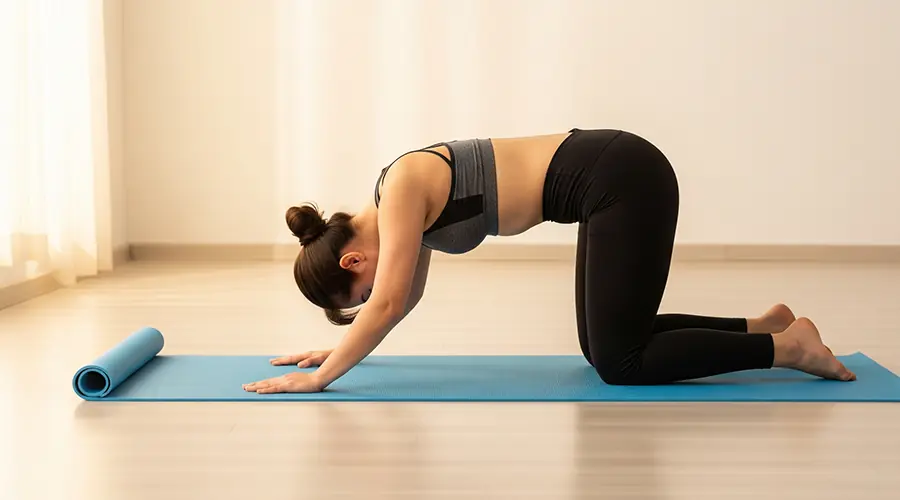
C) Low-Impact Aerobic Exercises
Aerobic exercises help improve blood flow to the back muscles, reduce stiffness, and boost overall endurance.
-
Walking: Start with short, regular walks (e.g., 10 to 15 minutes) and gradually increase the duration.
-
Stationary Bicycling: An excellent option for strengthening leg and back muscles without putting excessive stress on joints.
-
Swimming or Water Aerobics: The buoyancy of water relieves pressure on joints, making it a fantastic way to strengthen all body muscles, especially the back.
4. Who Can Benefit and How to Maintain Your Progress
Physiotherapy is often part of a comprehensive program.
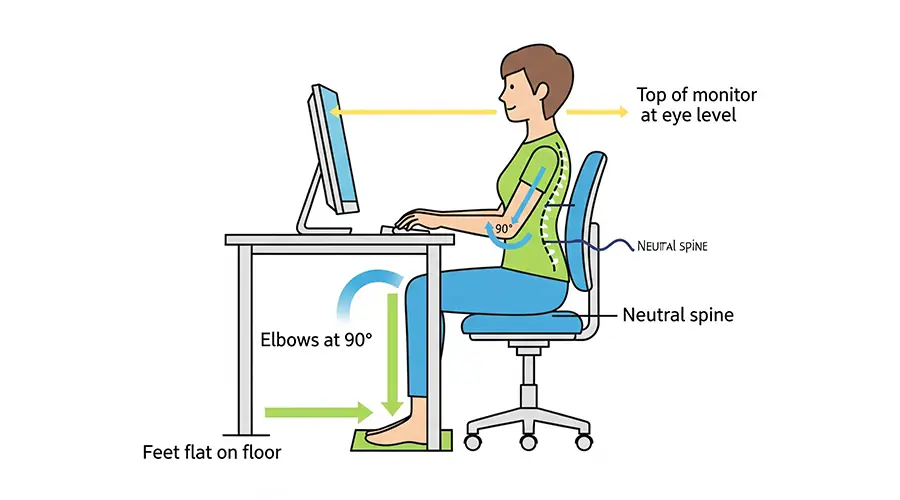
Types of Back Pain Treatable with Physiotherapy:
Physiotherapy is effective for a wide range of lower back pain issues:
-
Axial Back Pain: Pain that has no specific cause and is often due to muscle strain.
-
Sciatica: Pain that radiates from the lower back down the leg, usually related to pressure on the sciatic nerve.
-
Degenerative Disc Disease: The natural wear and tear of the spine's discs with age.
-
Spinal Stenosis: The narrowing of the spaces in the spine, which puts pressure on the nerves.
-
Post-Spinal Surgery Rehabilitation: Physiotherapy is essential for restoring strength, movement, and function after spinal surgery.
Key Tips for Self-Care and Prevention
-
Correct Your Posture: Keep your back straight when sitting, standing, and walking. Use ergonomic chairs at work.
-
Ergonomics at Work and Home: Position your computer monitor at eye level, use a proper chair, and get up and walk around for a few minutes every hour.
-
Manage Your Weight: Excess weight puts significant pressure on your spine. Maintain a healthy weight through a balanced diet and regular exercise.
-
Proper Sleep: Sleep on a suitable mattress. If you sleep on your side, place a pillow between your knees to keep your spine aligned.
5. Safety Considerations and Expert Recommendations
Warnings: When to See a Doctor? In some cases, back pain can be a sign of a more serious problem. If you experience any of the following symptoms, seek immediate medical attention:
-
Severe numbness, tingling, or weakness in your legs.
-
Loss of bladder or bowel control.
-
Severe and sudden pain that doesn't improve with any movement.
-
Pain accompanied by fever, unexplained weight loss, or trauma (e.g., after a car accident or fall).
Ready to address the root cause of your back pain? Our specialized physiotherapy programs in Dubaiare tailored to your unique condition. Contact us to book your assessment.
Conclusion:
Back pain is a manageable problem, and you can take control of your health with the right approach. By combining targeted physiotherapy, regular exercise, and modifying daily habits, you can find relief from pain and enjoy a more active and fulfilling life. Remember that your body is strong, and movement is its best medicine.



